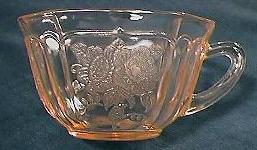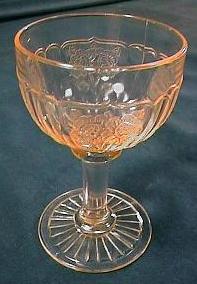
Mayfair by Hocking Glass
Written by Rosemary Trietsch
If you’ve been following my column the past few months, you probably noticed I’m in ‘Rose Mode.’ Well, it’s summer; the roses are blooming - at least those that my rabbit hasn’t eaten – so it seems the right time of year to examine glass that fits so well with the season. We already examined Mayfair, Rosemary, and Sharon by Federal Glass Company and saw how copyright problems forced Federal to redesign Mayfair into Rosemary, then scrap both in favor of Sharon, which used the same beautiful rose motif as the other two. This month, let’s take a closer look at Hocking’s “Open Rose” pattern – the one that caused all the problems for Federal Glass Company, but is perhaps the most collected pink depression glass pattern of all time: Mayfair.
Hocking Glass Company began in Lancaster Ohio in 1905 hand pressing small tableware items, lamp parts, and novelty pieces. By the mid 1920’s, they had begun the switch to automation and turned out their first line of machine pressed tableware in 1928. Circle, Spiral, and Block Optic were among the first patterns machine pressed, all made primarily in green. In 1930, Hocking introduced its first mold-etched pattern, Cameo, followed by Princess is 1931. (The term “mold-etched” refers to the way the actual glass molds are made. Instead of pressing the glass and then etching the pattern into each piece individually, the pattern is etched into the metal mold so that the pattern is pressed or molded into the glass.) Mayfair was the only other mold-etched pattern Hocking produced and it had the longest production run of the three, from 1931 to 1937.
Although pink – a.k.a. Flamingo - is the color most commonly found, it’s blue Mayfair that is most intriguing to collectors. Hocking developed a light, almost turquoise blue color sometime around 1930 and only used it for their Mayfair line. It’s a beautiful color – more vibrant than Sapphire blue and softer than the turquoise blue Dell Glass Company used for its Tulip pattern. There’s nothing quite like it in any other depression pattern and collectors grab whatever blue items they can find, almost regardless of the price. You will also find pink pieces that have been frosted (acid etched to give a satin finish) with hand painted flowers added. These may have started as a special order or promotion for the holidays, but there are enough satin pieces around today to put together complete sets which means that the demand was strong and Hocking complied. (If you’re ordering satin/painted pieces through the Internet or mail, make sure to inquire about the condition of the paint as it wears easily.) Hocking also produced a much more limited run of green and yellow Mayfair, with not all items available in these colors. A few pieces were made in crystal as well – most common are platters, salt & pepper shakers and pitchers – but as there are few collectors for crystal, there’s really no established value for these things. Buy them if you like them and the price is right.

Since I brought up price, let me tell you right now that collecting Mayfair in any color will require both patience and lots of money. If the idea of green or yellow Mayfair intrigues you, let me just say that the ‘book’ prices start at $85 each for ‘commonly’ found 8-½ inch luncheon plates and 9-½ inch grills. After that, it’s all triple digit figures. (Note: I stress that these are ‘book’ prices. Green and yellow items are quite scarce and actually sell for much more than ‘book.’) Blue and pink are slightly more affordable. That same 8-½ inch luncheon plate runs $55 in blue and $28 in pink. With lots of collectors competing for anything that’s offered for sale, Mayfair is a pattern for the ‘big game hunter’ who enjoys the thrill of the hunt and can be just a little ruthless when stalking that elusive dinner plate. (You know the scenario: you spot something you need, but you’re one booth over and someone’s reaching for it. Mayfair hunters are good at creating diversions, then diving through the smoke screen and snatching up their prize. Who says glass collecting is boring?)
As Mayfair had a relatively long production period, you’ll find variations in basic pieces that resulted from replaced moulds. The 12-inch oval platter can be found with closed handles or open handles. (The open handled platter is slightly larger at 12 ½ inches.) The foot on some tumblers is rayed, while others are plain. There are also variations in the height of the stems, especially on the 15-oz iced tea tumbler. Some of these have a short stem above the foot, while others have virtually no stem at all. This same height/stem variation is also true of footed sherbets. I bought a set of 8 from someone who purchased them new in the 1930’s and two of these sherbets were a little shorter with the glass more thickly molded. Remember: variations of up to ½ inch and from 1 to 4 oz. are the result of mould variations and can even be caused by the company rounding off measurements for their catalog listings. (15 oz is much easier than 14 ¾ oz to list and the ¼ oz difference didn’t bother folks back then; though it drives today’s collectors to distraction.) If your dinner plate measures 9 ¼ inches instead of 9 ½ inches, you haven’t found an unlisted item; you’ve just noticed a mould variation between plates.
An interesting variation found in the Mayfair line concerns the round items that have shown up. In general, the shape of the Mayfair line is a square with the corners cut and scalloped slightly – almost an octagon but not quite. The plates and bowls all have a flat edge, and the cookie jar, footed candy jar, pitchers, cup, creamer and sugar are square with paneled corners. But there are some round pegs in this otherwise square world. Round cups have turned up and there is a 6 ½ inch round plate as well. This plate is the saucer for the round cup when plain, (as is typical of Hocking patterns, the small plate doubles as a saucer) but it has also turned up with an off-center ring to hold a 2 ¼ inch flat sherbet, making a canapé set. All four of these pieces are difficult to find. The cream soup bowl is also round instead of square; in fact, it’s the exact same shape as the Cameo cream soup, right down to the scroll pattern on the handles. The very rare 3-footed console bowl is also very round and very similar in style to the Cameo 3-footed console bowl. Only a handful of these have turned up so far, but at $6000+, not many collectors can afford them anyway. It’s nice to dream, though.

Mayfair seems to have more than its share of rare items, especially when you consider that there’s no such thing as a ‘common’ green or yellow piece. Besides the 3-footed console bowl, there’s a very rare footed salt and pepper shaker set that’s similar in design to the Miss America shaker. It hasn’t been documented whether or not these were actually produced: Weatherman reported seeing a set in the Hocking morgue back in 1970, but never found a listing in the Hocking catalogs. At $9000+, they make the Cherry Blossom shakers downright cheap. The 1 oz cordial glass and 4 ½ oz claret will also take considerable hunting to track down – as well as plenty of money to bring home. Perhaps the most sought after of the rare items is the sugar bowl lid. Once in a while they do surface and if you have the money, they can be yours. If you were lucky enough to be in San Antonio back in February (as I was) for Kent Washburn’s amazing show, you might have met the Canadian collector who flew down to the show to pick up his Mayfair sugar lid for $5000. He figured the airfare was cheaper than the postage and he wouldn’t have to trust UPS. (By the way, the lid went home First Class; he flew coach.)
Even if you can’t afford any of these especially rare items, Mayfair has some wonderful pieces in interesting shapes to make your collection sparkle. Like Cameo, Mayfair has a decanter and stopper, though it was only made in pink. The stopper is hollow with the Mayfair panels and scallops on it. There is also a deep fruit bowl that’s similar in style to a top hat. The bowl is about 5 inches deep with a scalloped edge that flares out to a 12-inch diameter. This bowl fits in the center of the 11 ¾ inch shallow bowl – which really is more like a rolled edge torte plate than a bowl – and together they make a wonderful centerpiece. But my favorite piece has to be the sweet pea vase. It’s also hat shaped and the upper edge is crimped so it looks ruffled. As the crimping is done by hand, the diameter of the top will vary from 8 to 8 ½ inches and the height varies from 5 to 5 ½ inches. There’s no other vase shaped quite like it in any regular depression pattern.
Because of its popularity, Mayfair collectors have their share of reproductions to deal with. Luckily, the fakes are limited to 4 items that are easily distinguished from the originals. Cookie jars, shot glass, shakers, and juice pitchers have shown up in green, pink, amethyst, cobalt, and red. On all of these items, if you ignore the colors that Hocking never produced: the pattern is very badly molded, the glass has that greasy feel, and the green and pink colors are too light. For cookie jars and juice pitchers, the easiest way to tell old from new is to look at the bottom. Old pitchers and cookie jars have a mold circle on the bottom: new ones are missing this ring. Don’t worry about the top of the jar, as chances are good that a fake bottom will have a fake lid and visa versa. Also, the handles on the juice pitchers are strangely applied – they look like they drooped when the glass was hot – and are easy to spot. New shakers are slightly smaller than old shakers. If your eye can judge 1/16th of an inch, the new one is 4 inches tall instead of 4 1/16th inches tall. As I can’t judge that small an increment with a ruler, I feel the corner ridges: they’re very sharp on the repro pieces and smooth on the originals. With shot glasses, the pattern is so crudely done that your eye should tell you right away that something’s wrong: There’s a single stem under the flowers instead of two stems that form an ‘A’, and the details on the flowers are crude.
Despite amazingly rare and expensive pieces - and amazingly crude reproductions – Hazel Marie Weatherman said it best when she wrote: “Our old open rose design may well be the ‘mostest’ in many a collector’s book – most popular, most collectable, most variety of pieces, most widely collected…you name it.” (Book1, pg. 115) These words are as true today as 30 years ago when they were first written. Unfortunately for us, though, Hazel’s prediction is also coming true: “ Hundreds of carloads of Mayfair were sold in those five years of production, so it is no wonder there is so much available today. Plates and cups-and-saucers are becoming more scarce every day, however, and it will probably be no time at all before Mayfair is gone from the shelves.”(Bk1, pg. 117) So, dear Mayfair collectors, put on your comfortable shoes, leave slow friends at home and head for the nearest glass show as time is running out. Carpe Deum!